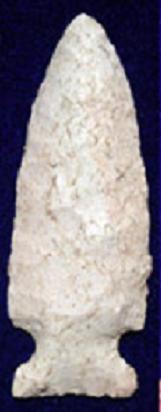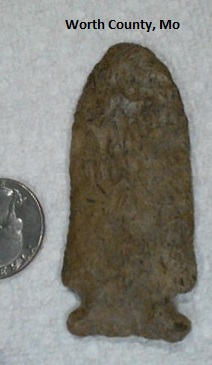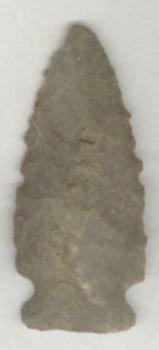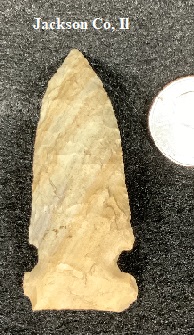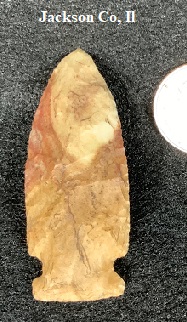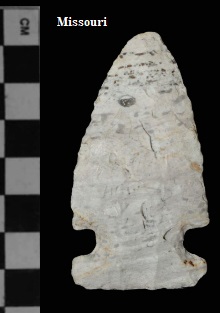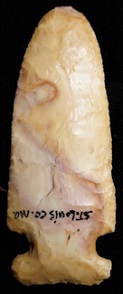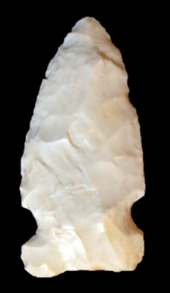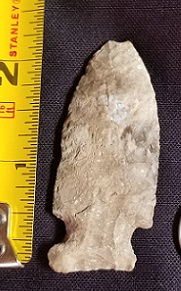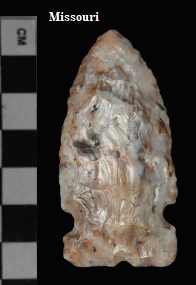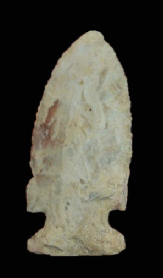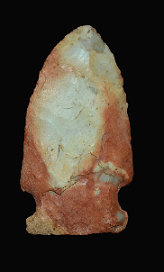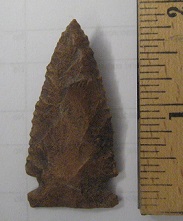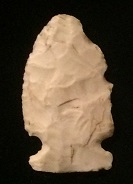Outline is Representative of Size and Shape:
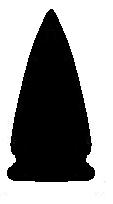
Name Details:
Identifd By: Anta Montet-White (describe) / Gregory Perino (named)
Named For: Type Site / discovered by Al Godar in 1940
Date Identified: 1968 / 1971
Type Site: Godar Site, Calhoun County, Illinois
Identifd By: Anta Montet-White (describe) / Gregory Perino (named)
Named For: Type Site / discovered by Al Godar in 1940
Date Identified: 1968 / 1971
Type Site: Godar Site, Calhoun County, Illinois
Point Validity:
Valid type
Montet-White is a distinguished anthropologist and Professor Emeritus of anthropology at the University of Kansas. Perino was a well-respected self-taught archeologist who was the founder of the Illinois State Archeological Society. This point was named in a professional publication and has professional references to this type. This is a valid type.
Montet-White is a distinguished anthropologist and Professor Emeritus of anthropology at the University of Kansas. Perino was a well-respected self-taught archeologist who was the founder of the Illinois State Archeological Society. This point was named in a professional publication and has professional references to this type. This is a valid type.
Godar Side Notch
AKA: Black Sand (Scully, 1951)Cluster: Large Side Notch Cluster
Description of Physical Characteristics and Flaking Pattern:
This is a medium triangular side notched point with a flattened to elliptical cross section. The blade is broad and may range from straight to excurvate and commonly finely serrated. Some examples have the tip curving in with the blade becoming parallel to the shoulders. U shaped notches are as wide as they are deep. The shoulders are primarily horizontal with an expanded stem. The stem is short and usually equal in width as the shoulders. The base is primarily straight to slightly convex. The basal area may vary from a squarish to rounded appearance with basal thinning, with flakes commonly extending the length of the notches and light to moderate hafting region grinding present. This point is manufactured by random percussion flaking with finishing and retouching pressure flaking forming a random flaking pattern with good workmanship.
Size Measurements:
Total Length - 54 to 140 mm, Stem Length - 13 to 20 mm,, Blade Width - 22 to 40 mm, Notch Depth - 4 to 8 mm (typically 5 to 6 mm), Stem Width - 22 to 40 mm, Thickness - 9 to 11 mm
Total Length - 54 to 140 mm, Stem Length - 13 to 20 mm,, Blade Width - 22 to 40 mm, Notch Depth - 4 to 8 mm (typically 5 to 6 mm), Stem Width - 22 to 40 mm, Thickness - 9 to 11 mm
Commonly Utilized Material:
Various local materials with heat treatment only being used occasionally.
Various local materials with heat treatment only being used occasionally.
Additional Comments:
Morrow (2016) notes that the Godar point and Raddatz point have essentially the same morphology. It could also be argued that they the two type designation are provincial rather than typological. Medium sized, side-notched points in Illinois are referred to as Godar and medium-sized, side-notched points in Wisconsin referred to as Raddatz. Like most Middle Archaic side-notched types, when looking at the typical point, there is a difference is shapes, but as the characteristics of the type move way from what is typical, the two types begins to overlap making it difficult to distinguish the two types without knowing what other contextual components they are associated with.
A variation to the Godar point is the Brannon point. Martens (2009) notes that the Brannon type exhibits less bold notches (about 50% smaller than those on the classic Godar point). This point causes much confusion possibly because archaeologists in the greater St. Louis area do not use the Raddatz name and include the Brannon point in the Godar point category.
Morrow (2016) notes that the Godar point and Raddatz point have essentially the same morphology. It could also be argued that they the two type designation are provincial rather than typological. Medium sized, side-notched points in Illinois are referred to as Godar and medium-sized, side-notched points in Wisconsin referred to as Raddatz. Like most Middle Archaic side-notched types, when looking at the typical point, there is a difference is shapes, but as the characteristics of the type move way from what is typical, the two types begins to overlap making it difficult to distinguish the two types without knowing what other contextual components they are associated with.
A variation to the Godar point is the Brannon point. Martens (2009) notes that the Brannon type exhibits less bold notches (about 50% smaller than those on the classic Godar point). This point causes much confusion possibly because archaeologists in the greater St. Louis area do not use the Raddatz name and include the Brannon point in the Godar point category.
Distribution: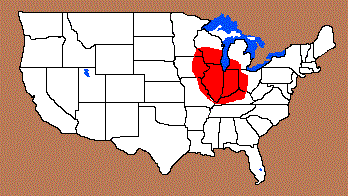
Distribution Comments:
These points are primarily found in the lower Illinois River valley and into the adjacent Mississippi and Missouri river valley's Distribution extends into the upper-mid to upper Mississippi River valley and into the Ohio River valley's.
These points are primarily found in the lower Illinois River valley and into the adjacent Mississippi and Missouri river valley's Distribution extends into the upper-mid to upper Mississippi River valley and into the Ohio River valley's.
Age / Periods:
Date: 4,500 - 3,500 B.P.
Cultural Period: Middle to Lakte Archaic
Glacial Period: Neoglacial
Culture: Red Ocher Culture
Date: 4,500 - 3,500 B.P.
Cultural Period: Middle to Lakte Archaic
Glacial Period: Neoglacial
Culture: Red Ocher Culture
Age Details:
Titterington Phase
Titterington Phase
Other points in this custer / Related / Associated Points:
Brannon (Godar Variant), Big Sandy ,Cache River Graham Cave, Greenbrier, Hemphill, Howard County, Madison Side Notched, Osceola, Osceola Greenbrier, Raddatz, Simonsen
Brannon (Godar Variant), Big Sandy ,Cache River Graham Cave, Greenbrier, Hemphill, Howard County, Madison Side Notched, Osceola, Osceola Greenbrier, Raddatz, Simonsen

